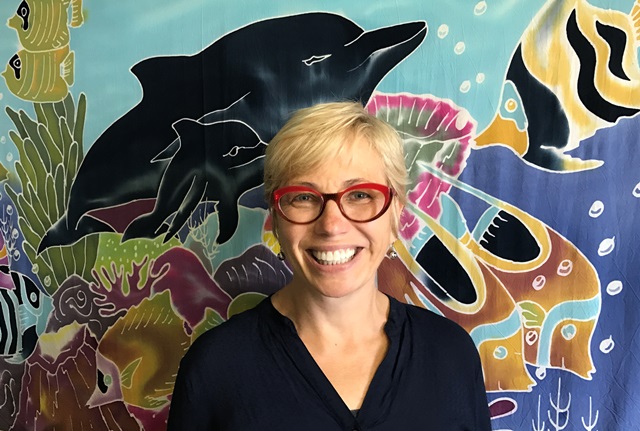
By Erica Di Maio
While Pat Larson is a nurse practitioner by trade, she wears many hats in her role supporting clients and staff in five non-medical withdrawal management sites across Toronto.
Although many Withdrawal Management Services (WMS) clients have increasingly complex medical complications, these sites are traditionally staffed by unregulated care providers, without access to primary care or medical services on-site. The integration of Pat’s clinical expertise for individuals requiring crisis support for withdrawal and substance use has led to transformational changes in the sector.
This shift began five years ago when the Toronto Central Local Health Integration Network created the Urban Telemedicine Initiative in Withdrawal Management Services. The project funds a Nurse Practitioner, Pat, to support the medical needs of five non-medical WMS, including: Michael Garron Hospital’s (MGH) Withdrawal Management Centre and Aboriginal Day Program, the University Health Network’s Women’s Own and Ossington WMS and St. Joseph Health Centre’s Glendale WMS.
Although Pat’s home base is at MGH’s Withdrawal Management Centre, she travels across WMS sites multiple times per week to offer clients medical expertise in their communities and provide enhanced support to non-medical WMS providers. This also includes consultations with clients and staff via telemedicine.
‘Sometimes, we need to be a bit of a detective agency’
When individuals with addictions try to abstain from using alcohol or other addictive substances, they might experience painful and uncomfortable physical and psychological symptoms, known as withdrawal. Depending on the substance, symptoms might include: nausea, vomiting, tremors/shakes, anxiety, and restlessness. In the most severe cases of alcohol withdrawal, individuals might experience seizures or delirium tremens.
“Individuals in withdrawal often want to make a change and it’s our job to help them safely though their journey. Our clients might be homeless or come from homes where others around them are using and they need a safe environment to stabilize,” says Pat, who has worked with individuals with addiction for more than 30 years.
Depending on the individual, withdrawal can continue for up to seven days for alcohol or 10 days for opioids. Clients are referred to a WMS by Central Access or the Emergency Department, and are placed in the next available bed.
“Sometimes we need to be a bit of a detective agency. We have clients come to us without medications and might not know the name of their pharmacy or family doctor. We begin our search with very limited information and try our best to connect the dots to help these individuals navigate the system and access the appropriate care or treatment,” says Pat.
The MGH Withdrawal Management Centre houses 30 beds, with eight dedicated to clients in crisis. WMS staff facilitate client intake and transfers and act as frontline counselors to offer one-on-one and group facilitation. Pat works closely with staff to coordinate medication reconciliation, complex client care, and focuses on the development of system-wide improvement strategies in collaboration with WMS supervisors.
Preventing unnecessary visits to the emergency department
Maria Spirkoski, Program Supervisor, Withdrawal Management Centre at MGH describes the integration of a nurse practitioner into a non-medical setting as one of the most significant shifts in WMS she’s observed in 20 years working in the field.
“With a changing population and in the midst of an opioid public health crisis, we have increasingly complex clients who might not only be dependent on multiple substances, but also have chronic medical conditions including liver disease, heart disease or diabetes.”
“Typically, we would send these clients to the emergency department given non-medical staff do not have the clinical expertise to manage these conditions. But with Pat on-site, she’s able to facilitate care for these complex clients and prevent unnecessary visits to the ED.”
According to a 2016/17 report for the Urban Telemedicine Initiative in Withdrawal Management Services, the total number of crisis and residential clients seen across WMS sites was 4,860, with 80 per cent – mostly male – seeking support for multiple reasons, including substance abuse, mental health, medical issues or challenges navigating the healthcare system. Of those clients, Pat was able to support close to 25 per cent. The report anticipates 11 per cent of clients were diverted from the ED as a result of successful consultation with a nurse practitioner.
As part of the Initiative, a Practice and Quality Steering Committee has been formed, including Pat and Supervisors across the WMS sites to standardize best practices and create guidelines to enable system-wide improvements. For example, creating a standard withdrawal management referral form for EDs, whereas previously, WMS sites would often not know whether a client had already been treated elsewhere or been given medication for withdrawal.
“The most vital part of this initiative is being embedded within the system,” says Pat. “By being on the frontlines, I can see where the difficulties and complexities are, and in turn, transform that into real system change.”
Erica Di Maio is Senior Consultant, Corporate Communications at Michael Garron Hospital.

